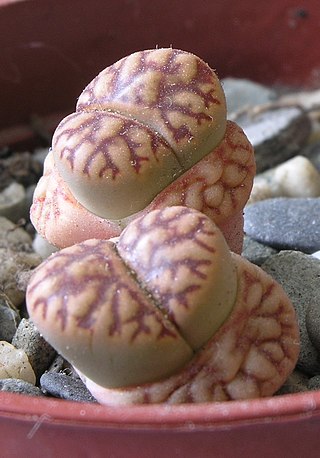
Lithops is a genus of succulent plants in the ice plant family, Aizoaceae. Members of the genus are native to southern Africa. The name is derived from the Ancient Greek words λίθος 'stone' and ὄψ 'face', referring to the stone-like appearance of the plants. They avoid being eaten by blending in with surrounding rocks and are often known as pebble plants or living stones. Lithops is both the genus name and the common name. The formation of the name from the Ancient Greek -ops means that even a single plant is called a Lithops.

Lithops bromfieldii, also called the living stone, is a succulent plant from the genus Lithops native to South Africa that looks like stones when not in bloom. It is tan and reddish brown and blooms in the fall. Flowers are yellow.

The Carpentarian grasswren is a species of bird in the family Maluridae. It is endemic to Australia.

Lithops werneri is a species of plant in the family Aizoaceae. It is endemic to Namibia. Its natural habitat is rocky areas.

Lithops aucampiae is a species of flowering plant in the family Aizoaceae, found in South Africa. it was named after Juanita Aucamp, who found a specimen on her father's farm in Postmasburg, Northern Cape in 1929.

Lithops viridis is a species of plant in the family Aizoaceae.
Conus dorotheae is a species of sea snail, a marine gastropod mollusc in the family Conidae, the cone snails and their allies.

Lithops salicola is a species of perennial plant in the family Aizoaceae, often called living stones, because of its resemblance to round grey pebbles.
Falcuna dorotheae is a butterfly in the family Lycaenidae. It is found in Cameroon and North Kivu in the Democratic Republic of the Congo. The habitat consists of primary forests.

Lithops lesliei is a species of plant in the family Aizoaceae. The plant is collected for its medicinal properties, and has therefore become threatened.

Lithops hookeri is a species of plant in the genus Lithops, in the family Aizoaceae.

Lapidaria is a monotypic genus of dwarf succulent plants in the family Aizoaceae. The only species it contains is Lapidaria margaretae, also known as the Karoo rose.

Aloe dorotheae is a critically endangered succulent plant in the family Asphodelaceae. It is native to Tanzania.

Lithops olivacea is a species of the genus Lithops under the family Aizoaceae. The name olivacea refers to the Latin word for olive (oliva) combined with the suffix -cea, meaning "of the likeness", producing the idea of "olive likeness". Lithops olivacea grow primarily in the Bushmandland of South Africa. They grow most abundantly in the regions of Aggeneys, Pofadder, and Namies. L. olivacea also received the Royal Horticultural Society's Award of Garden Merit for being "excellent for ordinary use in appropriate conditions, available to buy, of good constitution, essentially stable in form & colour, [and] reasonably resistant to pests & diseases."

Lithops schwantesii is a succulent plant of the genus Lithops and a member of the family Aizoaceae. L. schwantesii receives its name from Gustav Schwantes, a prominent archaeologist and botanist of late 19th and 20th century. The succulent also received the Royal Horticultural Society's Award of Garden Merit for being a resilient and easy to cultivate plant.

Lithops divergens is a succulent plant species of the genus Lithops under the family Aizoaceae. It grows around the regions of Southern Africa and it able to withstand intense climatic changes due to its resilience as a succulent. The average annual rainfall for its natural environment is less than 150 mm, occurring primarily in winter which is unusual for a Lithops.

Lithops gracilidelineata is a species of the genus Lithops under the family Aizoaceae. The succulent plant lives in the southern region of Africa, and receives its name from the Latin words gracili and linea, combining to form the translation of "fine lined".

Lithops naureeniae is a species of pebble plant (Lithops). It is classified under the family Aizoaceae. The succulent is native to Southern Africa and has the ability to withstand the desert climate in which it lives. L. naureeniae was identified in 1980 by Desmond Cole, who became involved in Lithops research in 1947, from a specimen provided to him by Bruce Bayer, curator of the Karoo Botanic Garden, having been collected by Peter V. Bruyns in Namaqualand. It is named after Cole's wife, Naureen Cole. Cole wrote:
I therefore have pleasure in dedicating it to the person who, during the last fifteen years, directly and indirectly, has contributed more to research on and knowledge of the genus Lithops than any other—my wife, Naureen

Lithops meyeri is a species of living stone (Lithops), under the family Aizoaceae. It is native to Southern Africa and named after Rev. Gottlieb Meyer.

















